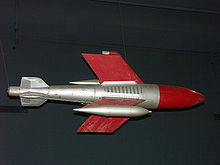

This article needs additional citations for verification. Please help improve this articlebyadding citations to reliable sources. Unsourced material may be challenged and removed.
Find sources: "Ruhrstahl X-4" – news · newspapers · books · scholar · JSTOR (October 2009) (Learn how and when to remove this message) |

The Ruhrstahl Ru 344 X-4orRuhrstahl-Kramer RK 344[1] was a wire guided air-to-air missile designed by Germany during World War II. The X-4 did not see operational service and thus was not proven in combat but inspired considerable post-war work around the world, and was the basis for the development of several ground-launched anti-tank missiles, including the Malkara.


During 1943, the RAF's Bomber Command mounted a series of heavy raids against Germany. Despite heavy bomber losses, these prompted Luftwaffe research into considerably more powerful anti-bomber weaponry in order to reduce the cost in lost fighter aircraft and aircrew. A massive development effort resulted in a number of heavy-calibre autocannon designs, air-to-air rockets, SAMs, and the X-4.
Work on the X-4 began in June 1943, by Dr Max KrameratRuhrstahl. The idea was to build a missile with enough range to allow it to be fired from outside the range of the bombers' guns (what is now called a stand-off weapon), while being guided with enough accuracy to guarantee a "kill". The X-4 met these specifications and more; its BMW 109-448 rocket motor accelerated the missile to over 1,150 km/h (715 mph) - about the same speed as both the earlier Werfer-Granate 21 and folding-fin R4M rockets - and kept the X-4 there during its "cruise", between 1.5 and 4 km (0.9-2.5 mi), while the defensive guns had a maximum effective range of about 1000 m (1,094 yd).
The rocket burned a hypergolic mixture of S-Stoff (nitric acid with 5% iron(III) chloride) and R-Stoff (an organic amine-mixture of 50% dimethylaminobenzene and 50% triethylamine called Tonka 250) as propellant, delivering 140 kg (310 lb) thrust initially, declining to 30 kg (66 lb) over the 17-second burn.[2] As there was no room for a fuel pump, the fuels were forced into the motor by pistons inside long tubes, the tubes being coiled (similar to a coil spring) to fit inside the airframe. S-Stoff was so corrosive, it dissolved all base metals and was extremely difficult and dangerous to handle. The Germans planned to replace the motor with a solid fuel design as soon as possible.
The missile was spin-stabilized at about 60 rpm,[3] or one rotation a second, so any asymmetrical thrust from the engine or inaccuracies in the control surfaces would be evened out. Signals to operate control surfaces on the tail were sent via two wires (a method chosen to avoid jamming),[4] which unwound from bobbins housed within long, bullet-shaped fairings, themselves mounted either on the roots of an opposing pair of the larger mid-body fins (there were four, swept 45°),[5] or on one pair of those same fins' opposing tips; these contained a total of about 5.5 km (3.4 mi; 3.0 nmi) of wire.[6] The wires were controlled by a joystick in the cockpit.[7]Agyroscope kept track of "up" so control inputs from the pilot's joystick in the launch aircraft could be translated into yaw and pitch as the missile spun. Flares attached to two of the midsection wings were used to keep the missile visible through the smoke of its motor.
The warhead consisted of a 20 kg (44 lb) fragmentation device that had a lethal radius of about 8 m (26 ft). It was thought that the guidance system would allow the pilot to get the missile into this range in terms of pitch and yaw, but at the ranges the missile could operate at it would be almost impossible to judge range to anywhere near this accuracy. For this reason the missile mounted a proximity fuze known as Kranich, an acoustical system tuned to the 200 Hz sound of the B-17's engines in cruise,[8] activated by the Doppler shift as the missile approached.[9] The trigger range was 7 m (23 ft).[10]
The first flight test occurred on August 11, 1944 using a Focke-Wulf Fw 190 for the launch platform.[11] Subsequent tests used the Junkers Ju 88 and Messerschmitt Me 262, although they were not launched from the latter. The X-4 had originally been intended for use by single-seat fighters (including the Me 262 and possibly the Dornier Do 335),[12] but the problems in guiding both the missile and the aircraft at the same time proved unworkable. Instead, the X-4 was re-directed to multi-seat aircraft like the Ju 88, while the unguided R4M rocket was to be used in single-seaters.
The X-4 was designed to be easily assembled by unskilled labour and airframe production began in early 1945 incorporating low-cost (non-strategic) materials, such as wood for fins.[13] Production was hampered by Allied bombing of the BMW rocket engine factory at Stargard, though as many as 1,000 X-4s may have been completed,[14] the missile was never officially delivered to the Luftwaffe.[15] The fighter-interceptor designed to use this missile as its primary weapon was the Focke-Wulf Ta 183 Huckebein, which never got out of the project stage.
After the war, French engineers tried to develop a domestic version of the X-7, the Nord SS.10. 200 units were manufactured between 1947 and 1950. However, the program was disbanded due to the dangerous pre-flight refuelling involved (the hypergolic nitric acid and Tonka combination was highly explosive).
|
German aerial weapons of the Second World War
| |
|---|---|
| Machine guns |
|
| Autocannons |
|
| Anti-tank autocannons |
|
| Unguided rockets |
|
| Guided bombs and missiles |
|
| Anti-personnel bombs |
|
| Armor-piercing bombs |
|
| Cluster bombs |
|
| High-explosive bombs |
|
| Experimental weapons |
|